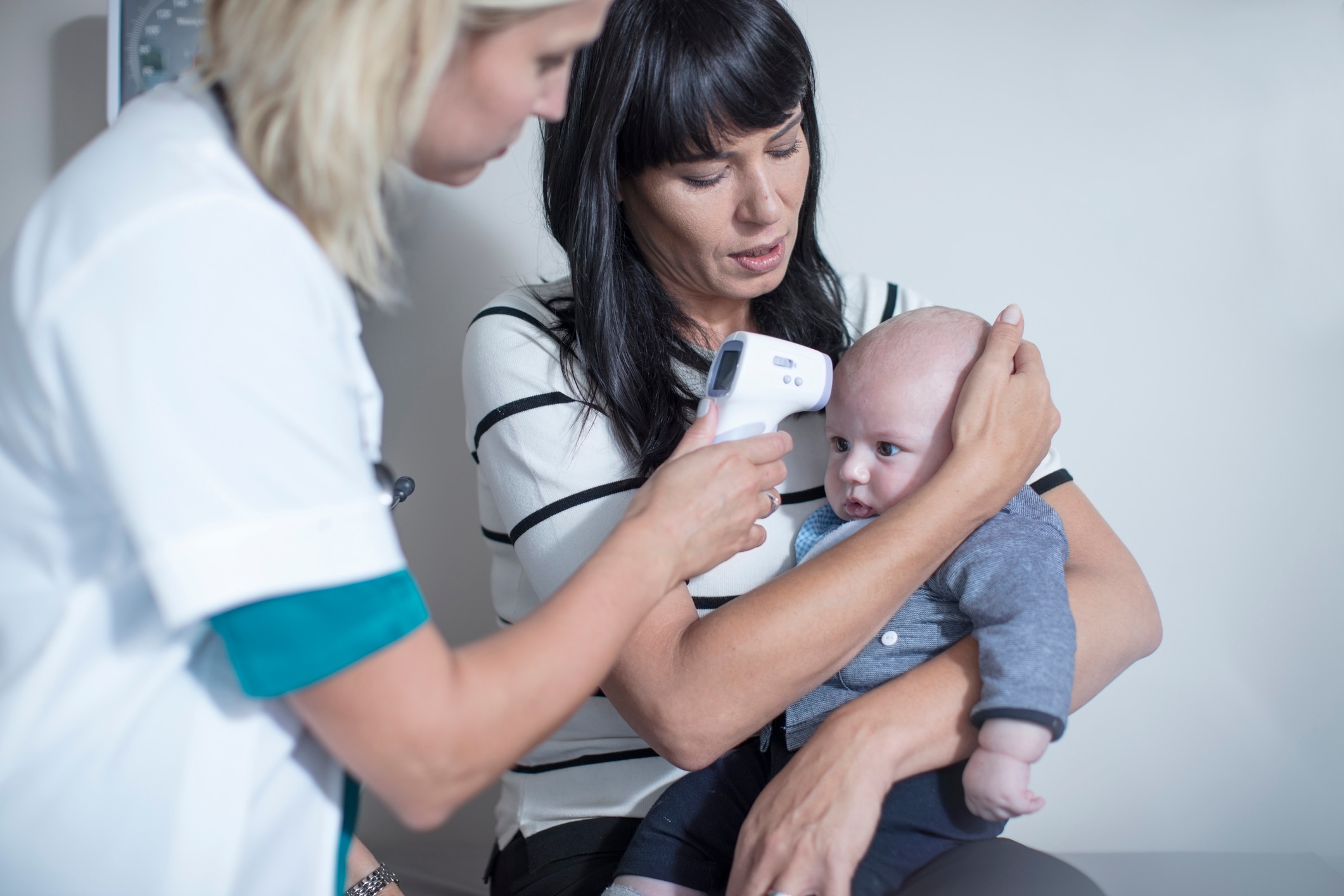Little bites can bring big surprises — at least if your baby is one of the 3% of infants and almost 9% of 1-year-olds in the United States with food allergies. And if you’re wondering what baby food allergy signs and symptoms to look out for and what to expect if they have a reaction, you might do well to learn from other parents who’ve been there.
“I’ve learned having the right mindset and a supportive allergy team surrounding you can go a long way as you’re learning to navigate the ups and downs of being a food allergy parent,” says Dr. Nana Mireku, a board-certified pediatric allergist at TexasAllergyMD and mother of two children with multiple food allergies. “It’s an emotional journey trying to keep your child safe, and it’s easy to be overwhelmed and anxious about managing their condition.“
From peanut butter kisses to egg-induced epiphanies, parents recall how they initially recognized their child’s food allergy signs and symptoms and how their baby’s diagnosis has impacted their parenting journey. Here are their stories and lessons they’ve learned.
1. It’s a lot to take in.
Nine years ago, Elizabeth Sherk, an Indiana-based teacher, was a first-time mom in her late 20s struggling to understand her infant son’s symptoms. “He was vomiting up my breast milk, wasn’t sleeping and wasn’t gaining weight,” she recalls. “He just didn’t seem like he could get comfortable, I didn’t know what I was doing wrong.”
Sherk started attending a breastfeeding support group run by her local hospital and credits the nurse there for validating her concerns and helping her on the road ahead. “I was exclusively breastfeeding, so the allergist we saw said the only way to get a definitive diagnosis was for me to do an elimination diet through my breast milk – and it would be a bit of trial and error to see if my son’s symptoms improved,” she says. “All of it was a lot to take in.”
“Parents often wrestle with feelings of guilt with questions like, ‘Why my child?’ or ‘Could I have done something differently during pregnancy?’ haunting them, even when they’re aware these factors are beyond their control,” says Dr. Ryan Sultan, a board-certified child psychiatrist, assistant professor of clinical psychiatry at Columbia University and director of the Mental Health Informatics Lab. “A support group, professional therapy or counseling can be a safe space to process and manage any symptoms of anxiety, guilt or depression and get strategies for mental resilience.”
Once he was old enough to start solid foods, Sherk’s son was diagnosed with a severe case of food protein-induced enterocolitis syndrome (FPIES), a delayed gut allergic reaction to food that typically presents in the first two years of life. While the condition does occur in about 1 in 7,000, FPIES in exclusively breastfed infants is very rare.
Unlike other food allergies, the majority of patients with FPIES have negative skin prick test responses, according to diagnostic guidelines published in the Journal of Allergy and Clinical Immunology. Even today, there aren’t tests to determine what concentration and what types of proteins are in a mother’s breast milk and how best to proceed with an elimination diet.
Sherk doesn’t know how she would have gotten through it without the support group. “I’m really grateful I was able to keep breastfeeding, because I don’t know how we would have afforded a speciality allergy formula on a teacher’s salary,” she says. Food allergy is still not considered an indication for specialty formulas under federal US health programs and private health insurance, and thus, recent findings indicate reimbursement for them is inconsistent and lacking.
“Through our experience, I’d already learned so much about the role genetics plays in developing food allergies.”
—Lauren Logeman
2. To prevent emergencies, educating yourself is key.
When out to breakfast with her 7-month-old Tomaž, Chicago-area mom Monika Ulrich gave some of the scrambled eggs from her meal to her son. He was just beginning to try solid foods, but by the end of the meal, red splotches appeared all around his mouth. “I immediately called our pediatrician and was referred to a pediatric allergist,” she says. “At that time, the allergist told us test results weren’t reliable for a baby that young and to just avoid giving him stove-top eggs.”
A couple months later, Tomaž started forcefully vomiting after having some noodles. “We didn’t realize until later that he also had huge, red hives all over his body,” recalls Monika. A blood and skin test later revealed he had severe food allergies to eggs, cow’s milk and peanuts.
Monika and her husband, Jason, were given an allergy action plan and a prescription for an epinephrine auto-injector to use anytime Tomaž had two or more symptoms of anaphylaxis.
“It can be a bit overwhelming as a new father,” says Jason, who leverages his experience working in the food manufacturing industry when checking food labels and ingredients. “Educating yourself is key.”
They’ve only needed to use the auto-injector once so far. “It was terrifying,” recalls Monika who gave her son the injection in his thigh while Jason held him down. “The Auvi-Q brand wasn’t covered by our insurance but it talks to you and tells you what to do while you’re doing it,” she says. “I was really glad we paid extra for it; when your adrenaline is rushing and you’re dealing with a screaming toddler, it’s hard to remember instructions you learned months before.”
Over the last several years, there’s been a lot of fluctuating prices of epinephrine, says Jodi Shroba, a pediatric nurse practitioner and coordinator of the Food Allergy Program at Children’s Mercy Hospital in Kansas City, Missouri. “Families need to purchase multiple sets, and it gets expensive.” She adds, “If your baby is in child care, for example, we recommend providing them with a two-pack of epinephrine; in rare instances both doses will be needed.”
3. Some babies are at a higher risk.
An hour after 8-month-old Connor had yogurt melts for the first time, he started vomiting. “My husband, Matt, and I chalked it up to too much sugar,” says mom Lauren Logeman, a physical therapist. “But when it happened again, I called our pediatrician and was referred to a pediatric allergist.”
Connor, now 3, was diagnosed with FPIES and also has terrible eczema. “For 18 months, we avoided anything with dairy and that was really hard,” says Lauren. “Slowly, we’ve started weaving dairy into his diet at the allergist’s recommendation; I wish we knew sooner having eczema would put him at a higher risk for food allergies.”
Nationally, one in five infants with eczema are allergic to peanut, egg white or sesame, compared to 1 in 25 infants without eczema.
When their youngest daughter, Nora, was starting solids, Lauren and Matt say they were both on high alert. “Through our experience, I’d already learned so much about the role genetics plays in developing food allergies,” Lauren says. “But, fortunately, she hasn’t had any issues.”
The chances of a younger sibling having a food allergy if an older sibling does is not as high as parents might think — but there is an increased risk. A study found only 13.6% of siblings of children with food allergies also had food allergies versus 8% in the general population.
4. Trust your instincts.
Thirty minutes after eating scrambled eggs for the first time, 10-month-old Anabel started vomiting with such force that her parents rushed her to the emergency room. “She was our first baby and we had no idea what was wrong,” says mom Katie Foster, a school-based speech-language pathologist who — over a decade later — still remembers the negativity of the emergency room nurse and the doctor who passed off what happened as “just a virus.”
Anabel was later diagnosed with an egg allergy after she had a similar severe reaction and hives the second time she ate scrambled eggs. “We rushed her to the ER again, but this time the on-call pediatrician advised us not to give her eggs or anything made with them for six months,” Foster recalls. “It was really hard at first, but we gradually weaved them back into her diet as she got older without any issues.”
Nearly one in 100 children in the US have an egg allergy, with the highest rates in children under age five. Research also finds children with egg allergies visit the ER for an allergic reaction more than children with any other type of food allergies.
“If I could go back, I would have trusted my instincts and not listened when the ER initially told me it was just a virus,” says Foster. “Maybe I could have prevented her from having that second reaction, but I did the best I could with the information I had at the time and that’s all any parent can do.”
The Foster’s story highlights a hard truth that many first-line providers need additional training and education on infant anaphylaxis — a point Shroba makes in her 2020 article published in the Journal of the American Association of Nurse Practitioners. She writes: “Symptoms in infants are often under-recognized because they may be mistaken for other illnesses. Given the serious consequences of misdiagnosis, the importance of proper identification and timely treatment of anaphylaxis cannot be overstated.”
“If I could go back, I would have trusted my instincts and not listened when the ER initially told me it was just a virus. Maybe I could have prevented her from having that second reaction, but I did the best I could with the information I had at the time and that’s all any parent can do.”
—Katie Foster
5. It will be an adventure that requires advocacy.
Darren Dahlin and Sunny Fenton began their food allergy parenting journey after their youngest son, Franklin, had an allergic reaction to hummus in daycare. “His face blew up like an elephant,” recalls Darren. Franklin, then only 1, was diagnosed with allergies to peanuts and sesame, an ingredient commonly found in hummus. “It’s been an adventure ever since,” he says. “We carry an Epipen everywhere we go, check every food label and cross restaurant after restaurant off our list due to a lack of allergy awareness.”
Fortunately, there is some progress being made to ensure safer food preparation and proper labeling. In a recent LinkedIn post, Fenton shared information about the new FDA food labeling requirements for sesame, which took effect on January 1, 2023. “Eating out at this point is almost impossible unless I’ve spoken to a restaurant prior and have the ability to read labels and know what’s in their kitchen,” she writes, referencing her support for the “Protecting Children with Food Allergies Act,” a federal bill being proposed by US Senators Dick Durban and Tammy Duckworth that would require formal training for food service workers in schools.
In Minnesota, where the family lives, sesame is not named as an allergen in the Department of Health food code, and Fenton says places like groceries, bakeries and restaurants have varying levels of understanding and implementation of the new food labeling requirements for sesame. “In my heart, I know we can work together to increase awareness and educate the broader community about food allergies and keep kids safe.”
The bottom line: You’re not alone
In a world where information overload can be paralyzing, the wisdom of fellow parents and professionals becomes a beacon in the storm. These stories, while all focused on the complexities of baby food allergies, share sentiments of moms and dads faced with unexpected challenges early on in their parenting journey. If you find yourself navigating a similar uncharted path, know you’re not alone. Lean on your village and find strength in the collective experiences of those who have walked before you.
“Food allergies are challenging, but having a supportive allergist team to surround you as you manage the ups and downs can go a long way,” says Dr. Mireku. “I applaud all of the food allergy parents and families keeping their children safe everyday. You are true heroes.”





